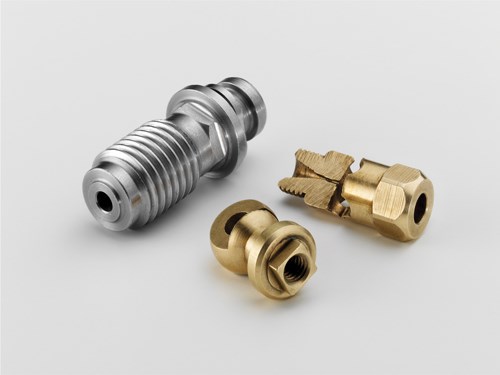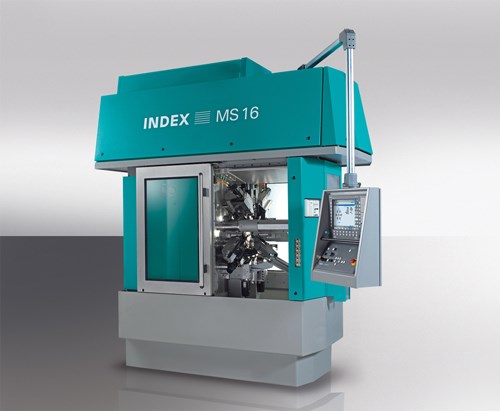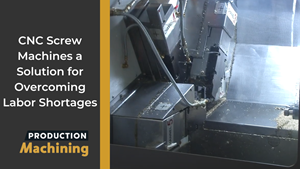New CNC Multi-Spindle Designed for Form Tools
Advances in technology can be disruptive. However, some advances can provide new possibilities for existing methods and tools leading to leaps forward in efficiency and effectiveness.
Advances in technology can be disruptive. However, some advances can provide new possibilities for existing methods and tools leading to leaps forward in efficiency and effectiveness.
That is the case for a new Index Corp. multi-spindle, the MS16, introduced at IMTS 2012. It is a compact, CNC six-spindle machine with 16-mm bar capacity and is designed to use single-axis plunge cuts with form tools. Some might say it’s a bit like back to the future.
Form tools have been used for decades on cam-type multi-spindles. They create profiles in parts quickly—which are especially useful for the cross-slide stroke on cam machines and are a fast method of turning multiple part features.
CNC multis, on the other hand, have offered more flexibility and shorter setup times. Therefore, the industry increased its use of CNC multis with preset single-point tools that could take advantage of the programmable, servo-driven, compound slides in the Z-axis positions.
The trend toward using single-point turning tools on CNC multi-spindles resulted in part because carbide form tools were seen as expensive, shorter lived and required longer leadtimes than off-the-shelf indexable insert tooling. However, there is generally a sacrifice in cycle time because a single-axis plunge stroke is faster than an interpolated two-axis motion.
Carbide cutting tools have steadily replaced high speed steel as machine tool feed and speed capabilities have improved. However, the EDM process used to create carbide form tools in the past could damage the coating and substrate of the carbide because of a lack of precise spark control on the EDM machine. At the cutting speeds currently used, this damage leads to shorter tool life.
Recently however, there has been a resurgence in the use of form tools because of improvements in the EDM process, primarily finer control of the spark. This results in a high precision tool edge with less substrate and coating damage leading to a longer lived tool, thus reducing tool change frequencies. Today’s form tools can be mounted to uni-directional slides in the CNC multi, controlled by the CNC part program, providing a plunge axis for part processing.
Responding to this processing improvement in form tool quality, because of technical advancements in the EDM process, Index developed its newest CNC multi, the MS16.
The six-spindle CNC automatic production lathe is a compact, innovative machine built on the Index multi-spindle modular system and is aimed at the cam-driven multi-spindle market. It deploys form tool slides as well as full CNC tool slides plus a backworking spindle to provide drop times to less than 3 seconds, giving shops the best of both cam and CNC worlds.
Each spindle offers independent, infinitely variable speeds up to 10,000 rpm. With smart NC drives, each driven tool can be synchronized with the C axis of the spindles to permit milling and polygon turning.
Liquid spindle cooling is a significant feature of the machine. It results in a higher power density in the spindle carrier, permitting high loads and high speeds without excessive heat generation. It also contributes to thermal stability. In addition, energy recovered from the heated cooling fluid can be profitably used in the plant.
The X-axis slides provide high dynamic stiffness with steel-on-steel, matched box-type guideways, resulting in high precision machining. Z-axis slides are quill-type with hydrostatic bushings. The five form tool slides work in the X axis and feature Index’s W grooves, which make for easy tool adjustment, according to the company.
Backworking is accomplished with a Z-axis synchronized spindle. As many as three backworking tools may be used as well as a cutoff tool, providing even more machining in a single rapid cycle.
Other features of the machine include a spindle-integrated bar feeding unit—further support of short cycle times—and an integrated chip conveyor.
The standard version of the MS16C includes 24 CNC axes, five forming slides in the X axis, two drilling slides, three compound slides with X/Z axis, a cutoff slide with backworking and X/Z axis, and a Synchron spindle in the Z axis. The machine can also be configured with 26 CNC axes, five forming slides, five compound slides, a cutoff slide and the Synchron spindle for backworking.
The new MS16 performs all operations expected of turning centers, including turning, drilling, milling, polygon turning, hobbing, tooth milling, deep-hole drilling or slotting. All standard toolholders and toolholder system interfaces can be used with the appropriate adapters (Capto, HSK, VDI, Index systems).
The cross slides with integrated drive have a low-mass design with hydrostatic bearing support. A low moment of inertia and the resulting high dynamics mean outstanding acceleration and further cycle time savings.
The advantage of the hydrostatic quill-type slide is that it prevents the transfer of the machining vibrations to the adjacent slide via the headstock. This helps to minimize vibration and rattling while workpieces are being machined, even when the most diverse machining processes are being performed concurrently by the spindles. One spindle can be used for heavy duty roughing while high precision finishing takes place on another spindle without sacrificing surface quality. In addition, the hydrostatic bearing is wear-free – there is neither friction nor a stick-slip effect.
Adding the ability to effectively use form tools to the CNC tools on the MS16 offers the precision parts producer a more economical, very high speed production lathe with the flexibility and short setup times of CNC and the short cycle times of form tools. For certain parts, this combination promises to drastically reduce cost per piece, the manufacturer says.
Related Content
Video Tech Brief: CNC Screw Machines a Solution for Overcoming Labor Shortages
CNC screw machines can exceed job shop productivity and enable manufacturers to overcome perpetual employment gaps.
Read MoreCAM-Driven Lathe Questions
There can be hidden issues using legacy cam-driven lathes that can be overcome using new CNC technology. Here are three to keep in mind.
Read MoreMethods Multitasking Machine Reduces Cycle Times
Methods Machine Tools Inc. introduces Nakamura-Tome’s WY-100V two-turret, twin-spindle precision CNC multitasking lathe to the U.S. market.
Read MoreBridging the Gap Between Traditional Single- and Multi-Spindles
This twin-spindle automatic lathe with six cross-slide mounted turrets is designed for medium-sized production runs that might not be suitable for conventional multi-spindles.
Read MoreRead Next
Do You Have Single Points of Failure?
Plans need to be in place before a catastrophic event occurs.
Read MoreA Tooling Workshop Worth a Visit
Marubeni Citizen-Cincom’s tooling and accessory workshop offers a chance to learn more about ancillary devices that can boost machining efficiency and capability.
Read MoreEmerging Leaders Nominations Now Open
Here’s your chance to highlight a young person in your manufacturing business who is on the path to be a future leader moving your company forward.
Read More











.jpg;maxWidth=300;quality=90)
.jpg;maxWidth=300;quality=90)












